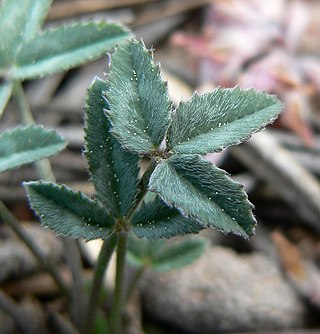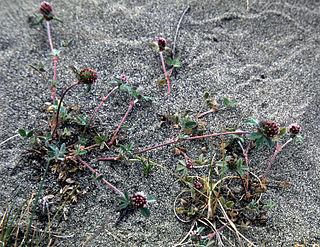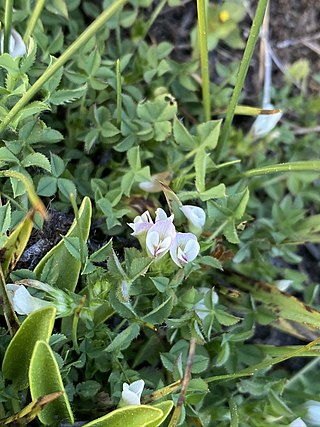
Stylocline micropoides is a species of flowering plant in the family Asteraceae known by the common names woollyhead neststraw, woollyhead fanbract and desert neststraw. It is native to the southwestern United States and northern areas in the northern states of Mexico, where it grows in desert habitat and other dry areas. It is a small annual herb growing at ground level with stems up to 20 centimeters in length. It is woolly or felt-like in texture with a coating of white hairs. The pointed leaves are up to 2 centimeters long and alternately arranged. The inflorescence bears spherical flower heads no more than a centimeter in diameter. The head generally has no phyllaries, or has small ones that fall away early. It contains several woolly white flowers.

Trifolium albopurpureum is a species of clover known by the common name rancheria clover.
Trifolium andersonii is a species of clover known by the common names fiveleaf clover and Anderson's clover. It is native to the western United States, particularly the Great Basin and adjacent high mountain ranges, including the Sierra Nevada. It was named after Charles Lewis Anderson by Asa Gray.

Trifolium angustifolium is a species of clover known by the common names narrowleaf crimson clover, narrow clover and narrow-leaved clover.
Trifolium barbigerum is a species of clover known by the common name bearded clover.
Trifolium beckwithii is a species of clover known by the common name Beckwith's clover.

Trifolium bifidum is a species of clover known by the common names notchleaf clover and pinole clover. It is native to the western United States from Washington to California, where it grows in many types of habitat. It is an annual herb spreading or growing erect in form. It is lightly hairy to hairless in texture. The leaves are made up of oval leaflets 1 to 2 centimeters long, usually with notches in the tips. The inflorescence is a head of flowers up to 1.5 centimeters wide. Each flower has a calyx of sepals that narrow to bristles covered in long hairs. The flower corolla is yellowish, pinkish, or purple and under a centimeter long. The flowers droop on the head as they age.
Trifolium bolanderi is a species of clover known by the common names Bolander's clover and parasol clover.

Trifolium depauperatum is a species of clover known by the common names cowbag clover, poverty clover, and balloon sack clover.

Trifolium fucatum is a species of clover known by the common names bull clover and sour clover. It is native to the western United States, where it grows in many types of habitat, becoming common to abundant in some areas. It is an edible species of clover.
Trifolium gracilentum is a species of clover known by the common names pinpoint clover and slender clover. It is native to western North America including the west coast of the United States and northwestern Mexico, where it grows in many types of habitat, including disturbed areas. It is an annual herb growing prostrate to erect in form with mostly hairless or slightly hairy herbage. The leaves are made up of lance-shaped to oval leaflets. The inflorescence is an umbel of flowers that spread out or flex downward. The flowers have pink or purple corollas less than a centimeter long.

Trifolium gymnocarpon is a species of clover known by the common name hollyleaf clover.
Trifolium lemmonii is a species of clover known by the common name Lemmon's clover.

Trifolium macraei is a species of clover known by the common names Chilean clover, double-head clover, and MacRae's clover. It has a disjunct distribution, occurring on the coastline of Oregon and California in the United States, as well as in South America. It grows in coastal habitat, such as sand dunes, and disturbed areas. It is an annual herb taking a decumbent or erect form. The leaves are made up of oval leaflets 1 to 2 centimeters in length. The inflorescence is usually made up of two oval or rounded heads of flowers each measuring up to 1.5 centimeters wide. Each flower has a calyx of sepals which taper into densely hairy bristles. The flower corolla is purple or bicolored with white or pink.

Trifolium macrocephalum is a species of clover known by the common name largehead clover or bighead clover native to the Great Basin region of the western United States.

Trifolium microcephalum is a species of clover known by the common names smallhead clover and small-headed clover.

Trifolium monanthum is a species of clover known by the common name mountain carpet clover.

Trifolium obtusiflorum is a species of clover known by the common name clammy clover. It is native to California in the Peninsular, Transverse, Sierra Nevada, and the California Coast Ranges and Cascade Range into southwestern Oregon.

Trifolium variegatum is a species of clover known by the common name whitetip clover. It is native to western North America from southern Alaska and British Columbia to Baja California, where it occurs in many types of habitat.
Trifolium jokerstii is a rare species of clover known by the common names Jim's clover and Butte County golden clover. It is endemic to Butte County, California, where it is known from eight or nine occurrences near Oroville. It grows in seasonally moist habitat, such as vernal pools, pastures, and ephemeral creeks. It was previously included within the description of Trifolium barbigerum as an odd yellow-flowered variant of a mostly purple-pink-flowered species, and was elevated to species status in 1998. It was named for the California botanist Jim Jokerst.













